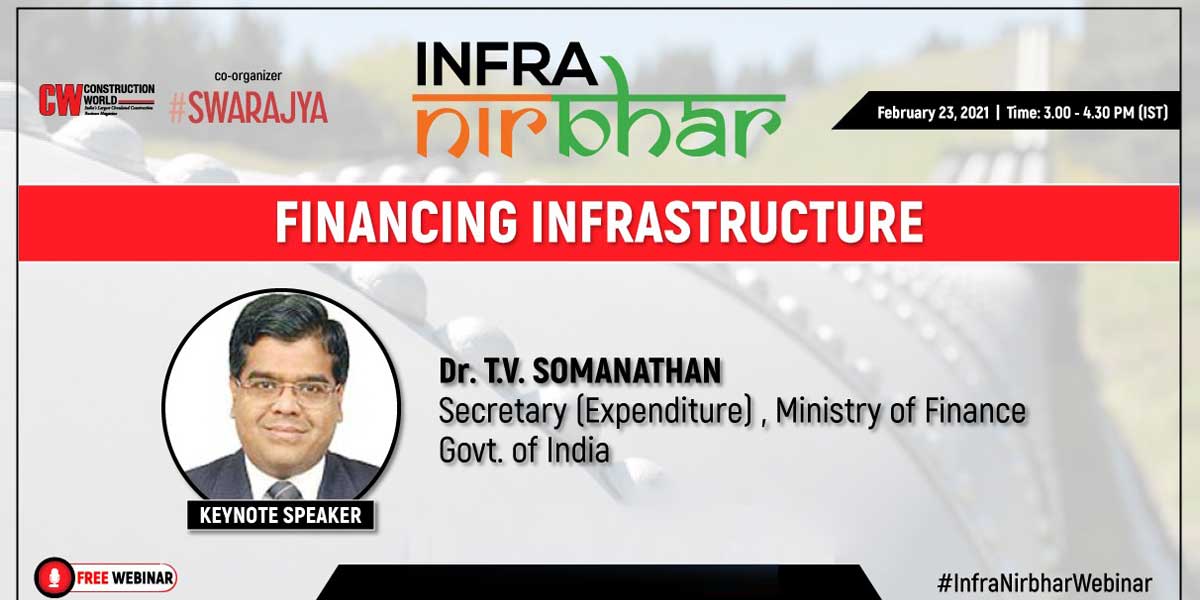

Captains of industry shared their ideas on Tuesday about infrastructure funding, inadequacies of the present system and way forward at “Financing National Infrastructure Pipeline”, the second webinar of the Infra-Nirbhar series organised by Construction World and Swarajya magazines. Dr TV Somanathan, Secretary (Expenditure), Union Ministry of Finance, was the keynote speaker.
In his keynote address Somanathan explained why infrastructure finance cannot consider only an internal rate of return, but must look at it from a wider social returns perspective.
To access the exclusive Q&A with Dr TV Somanathan, click:
Infra projects need a leap of faith: Somanathan
Other speakers at this webinar were:
Bharat Parekh, Executive Director, Infrastructure Research, CLSA
Palash Srivastava, Deputy CEO, IIFCL
Sudhir Hoshing, Joint MD, IRB Infra
Suneet Maheshwari, Founder & Managing Partner, Udvik Infra
Dr Shubhada Rao, Founder, QuantEco Research (Co-Moderator)
Pratap Padode, Editor-in-Chief, Construction World (Co-Moderator)
As we have analysed before, major theme of the Budget is that of asset monetisation: The Budget envisages monetisation as a very important option for increasing funding and financing of infrastructure creation. The Budget has announced the creation of a National Monetisation Pipeline of potential brownfield infrastructure assets as well as the launch of an asset monetisation dashboard for tracking the progress and to provide visibility to investors. Amongst the projects and initiatives announced as part of the asset monetisation initiative are the following initiatives in the airports and railway sectors:
Railways will monetise Dedicated Freight Corridor assets for operations and maintenance, after commissioning;
The next lot of airports will be monetised for operations and management concessions;
Other core infrastructure assets that will be rolled out under the asset monetisation programme are:
AAI airports in Tier 2 and 3 cities
Palash Srivastava, Deputy CEO, India Infrastructure Finance Company Ltd (IIFCL), explained two initiatives taken for asset monetisation, “first initiative is through State Road development Corporations’ efforts for capacity building and developing InvIT-like structures have been initiated for asset monetisation. The second is, most of the states want investment managers who they can really trust.” He said that there have also been deliberations in Niti Aayog about the need for a state-promoted asset manager who can implement asset monetisation.
Suneet Maheshwari, Founder & Managing Partner, Udvik Infrastructures, an infrastructure advisory firm, said, “The most important thing with respect to asset monetisation plans is sequencing, because of the investment rule that is available against confidence. If the sequence and the pipeline are set right, asset monetisation can be augmented.”
Bharat Parekh, Executive Director, Infrastructure Research, CLSA, an investment bank, said utility assets can be monetised:, “If I was given the mandate, I would actually monetise the state transmission, which is equally good, but it is the state utilities, which actually want that cash. It is that asset which is stuck out there, which nobody is willing to buy. If I could structure a state transmission asset into an infrastructure trust, maybe that will make sense, even if I don't want to sell it completely, but at least monetise it.”
She added, “In my opinion, as long as we provide policy predictability, consistency, and the ecosystem that enhances the confidence of the global players, I think equity━any day━is going to be a preferred route, both by the domestic government and even global players. So if we were to look at the funding mix, of course, debt will be a part of it, but wanting to lean on more, in our opinion should be equity.”
Maheshwari countered that point, arguing that one should be so tied down about whether we want more debt or more equity: “I think we need to create a very good pipeline of projects that are bankable and good. Once those are there, investors of all kinds will find India pretty attractive with debt as well as equity. They can take whatever [route] makes sense for them━as long as both of them will actually benefit us. So, I see no reason in saying we want to choose this or that our focus has to be good, get our old house back into order with respect to old cases, stuck projects, etc.”
According to Parekh, people have been surprised a lot more negatively. As long as these surprises are reduced, he believes, “private capital will come thick and fast because they are not here for charity”. Parekh suggested that the government needs to ensure it does not “change the rules in the middle of the game”.
When asked what needs to be done by the government to attract better private capital, Sudhir Hoshing, Joint MD, IRB Infra, said financing is not an issue as long as you have a well-structured project: “ In road projects, the liquidity requirement is only 12% to 16%. The risks are lower, so there also, you get a 10% mobilisation at once. And then you can actually move that money, use that money and slowly put it on your equity. That's why I think the government is bringing those types of projects, and the number is coming to that 21% mainly because of major projects. And there are very few BOT projects now. So if they can bring in BOT for different blocks where contractors or concessionaires can invest, say, 30-35% equity, those who can invest only 10%.
Those who cannot invest will take EPC blocks in the projects. That kind of apportionment can facilitate equity inflow.
There is confusion between corporate financing, bond financing and project finance, Maheshwari pointed out. Project financing is a slightly different skill with a slightly higher element of risk. “We need to design the structure internally. And a development finance institution (DFI) is a welcome move because with DFI there will be an annual result, we will have affordability designed and therefore, there are those guarantees. We think credit enhancement is like banking━ wrong. Credit enhancement is financial mathematics,” needing private sector skills, Maheshwari said.